2019 Audi A8 Level 3 autonomy first-drive: Chasing the perfect 'jam'
Most of the time I'll do my absolute best to avoid a traffic jam, but the 2019 Audi A8 makes them oddly appealing. Forget "Artificial Intelligence": the AI we're talking about today is Audi Intelligence. What exactly does this mean, and why should we care? We as a collective of road-users are going to need to be much more sensitive to the fact that there are cars on the road not being driven by human beings. Instead, we're increasingly going to see advanced driving assistance software taking the wheel, like the new Audi AI traffic jam pilot, the world's first Level 3 automated driving system in a production vehicle.
"Audi AI is innovative technologies that give customers greater convenience and values," Ellen Carey, Sr. Manager Innovation Communication Audi US, explains, "everything from vehicle automation to in-car customization."
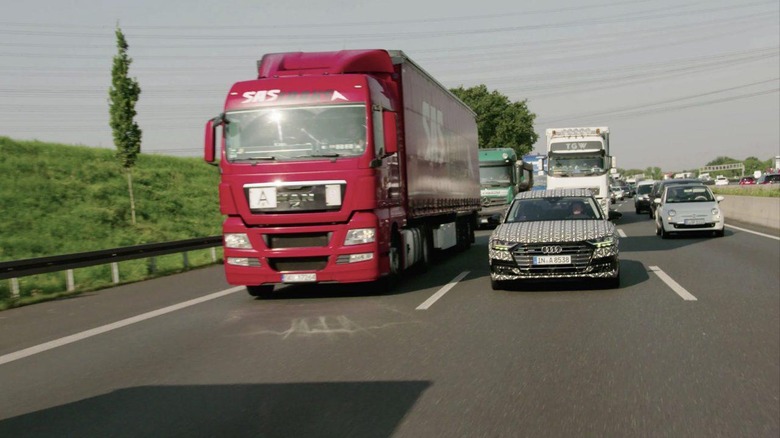
Digging deeper, Stefan Rietdorf, Development Automated Driving Functions for Audi AG explained to me that "AI describes the Audi intelligence that brings intelligent functions into the car, so one of these functions is the traffic jam pilot, others include Audi remote parking or Audi remote garage parking."
Who’s responsible when Audi AI traffic jam pilot is engaged?
There are so many questions surrounding the topic of self-driving cars, and Tesla's Autopilot approach arguably hasn't helped public perception much. It's important to understand how the more mature automakers are taking incremental steps towards handing over control to the vehicle. Tesla's philosophy is drastically different in that the system, while still Level 2 meaning it's officially "partial automation" and thus requires the driver's constant attention to resume control, allows prolonged self-driving for at highway speeds, in addition to being able to make lane changes.
That's not the case with Audi's AI traffic jam pilot. The first, and most important thing to note is that Audi has committed to owning 100-percent of the liability should something go wrong while the system is engaged.
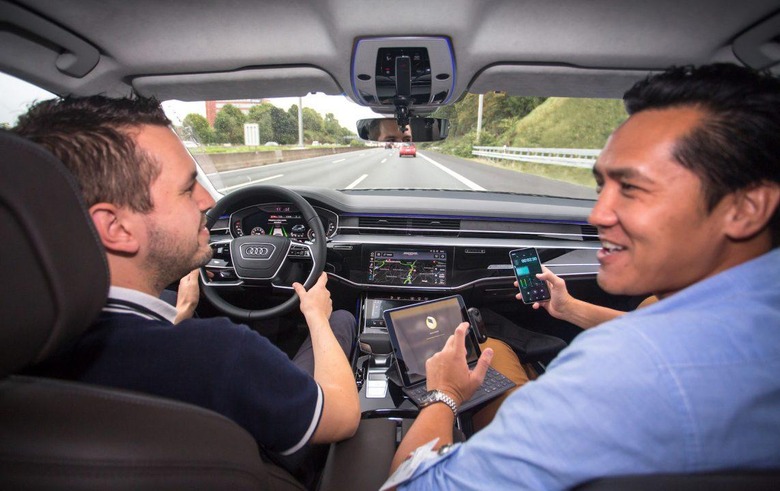
By definition, per the Society of Automotive Engineers, Level 3 autonomy can be activated in specific situations and environment such as highway driving where the car is in complete control, allowing the human driver to read, text or whatever they want. The difference between Level 3 and Level 2 is "you" the driver must be alert and ready to take over at any time.
Things get much more interesting in the realm of Level 4, which states that the car will drive itself independently in most environments, with some exceptions for weather or usual environments. The driver may still need to take over at times. With this Level 3 drive down, I'm expecting to hear more about Audi's plans for Level 4, so stay tuned.
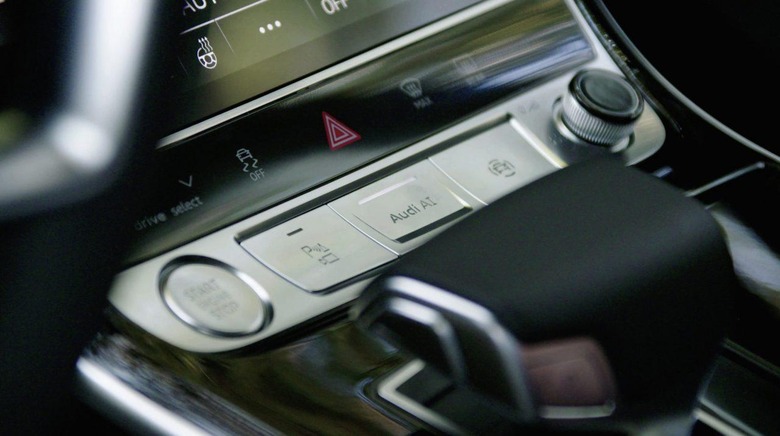
If you didn't understand the constraints around how the system works – and when you can and can't activate it – you'd be forgiven for thinking that it might be dangerous to release a car with Level 3 capabilities onto the road today. After my day grilling Stefan, though, I'm passed that initial concern. That comes down to a combination of targeted functionality and a rock-solid experience actually out behind the wheel of the 2019 A8.
AI traffic jam pilot isn't a feature that can simply be switched on and off when you want to. Again, because Audi is assuming all liability when the feature takes over the responsibility of "driving", every condition must be met before you get the green light to engage. And yes, you literally get green lights flanking the left and right edges of the Virtual Cockpit instrumentation, notifying you that the feature is available.
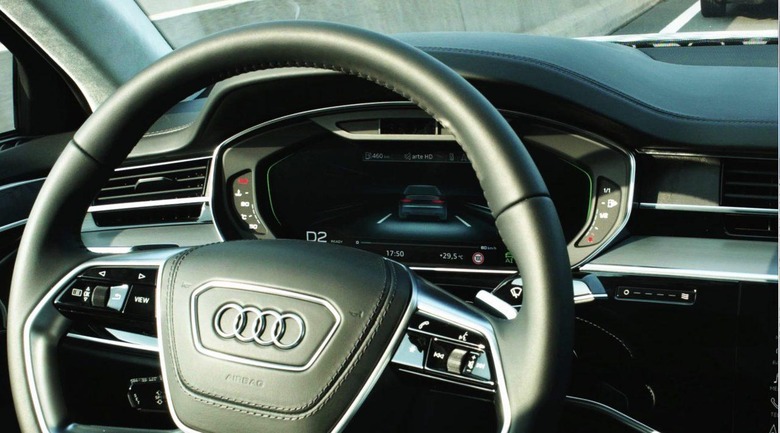
You need to be in a traffic jam, crawling at speeds below 37 mph or 60 kph, but that's just the start of it. The system also knows when you're no longer on the freeway via here HD maps, and as such will disengage the system. During our test route in Dusseldorf, Germany, the traffic jam pilot flagged that the system's assistance was coming to an end as we entered a rural area with stop lights and such. In short, if you're looking to take a nice drive through the mountains, leaving the A8 to handle the controls while you sightsee, don't count on it.
While I understand that Audi's taking extra precautions to keep you and everyone around you safe, I'm also very aware that many of the traffic slow-downs I'm stuck in are found within city limits. In such as case, Stefan tells me that, the system will revert to Level 2 semi-autonomous driving. The A8 will still articulate the pedals for stop and go traffic, but it's my job to steer the car. That means eyes on the road, hands on the steering wheel, and being ready to act if something goes wrong.
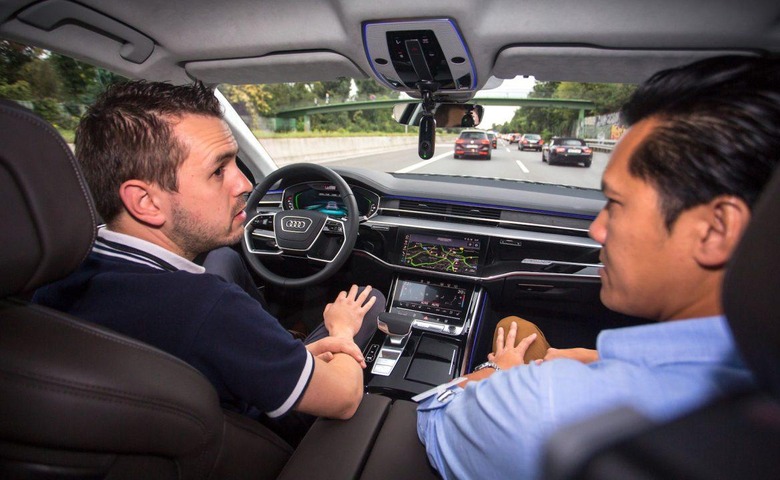
In contrast, with Level 3, you're permitted to take your hands off the steering wheel, your feet away from the pedals, and focus on anything but driving. The system handles starting from a stationary position, accelerating and braking, and sticking to its lane. It's also capable of handling real-world challenging issues, such as cars swerving into your lane, thanks to the intelligence implemented into the central driver assistance controller and from a redundant data fusion in the radar control unit.
Audi also takes into account what's around you, not just in front. For instance, there must be cars queued up next to you moving roughly at the same speed. If you happen to be driving in the far-left lane, the camera will detect whether there's a clear or physical barrier or divider preventing oncoming traffic from accidentally swerving over and causing a head-on collision, or vice-versa. There are many redundant sensors throughout the car, which monitor both the immediate surroundings as well as far into the distance.
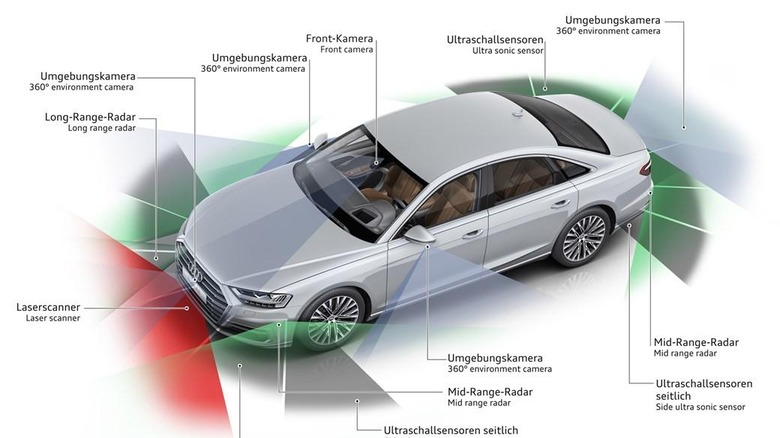
Honestly, I would pay whatever the cost is to have more time with the family, though the limitations of a Level 3 system still apply. You shouldn't completely check out, for example, and take a power nap. A small camera located in the driving area constantly monitors, detects, and analyzes your face and eyes for movements like whether your eyelids are blinking or not. Should you happen to fall asleep, the system will spot that your eyes have been closed for too long. At that point, you've guessed it, traffic jam pilot disengages and you've got 10 seconds to take over.
Right about now, you might be asking yourself "what if I completely refuse to take over the driving?" or, for medical reasons or otherwise, if you simply cannot do so? I encourage you to watch the video below. Here's what happens: through visual and audible warning alerts, you're told to take over while the A8 starts to decelerate. If you don't respond, the seat belt will start to tug at you with increasing force, while the audible alert increases as well. After that, the brakes start jolting to really get your attention.
During my test, forcing myself to ignore the escalating alerts, I concluded that 10 seconds of an increasingly frustrated car is more than enough for the system to grab my attention and force me to take over, assuming I'm able to. If I wasn't, the system remains in control and safely brings the A8 to a complete stop, turning on the hazard lights and the interior cabin lights, and then automatically calling for emergency services.
Is the technology advanced enough for Level 3?
The short answer is yes. Audi's "brain" for the system consists of the zFAS (central driver assistance control), the central computer handling most, if not all of the various elements of automated functionality. It's made by Delphi, and Audi tucks it somewhat appropriately underneath the driver's seat. It's a powerhouse mega-processor, based on the NVIDIA Tegra K1 to process a real-time 360-degree surround view to identify objects at close-range.
Working together with the zFAS is Mobileye EyeQ 3, an Altera Cyclone V chip with integrated ARM processor, and an Infineon Tricore chip, which together do most of the heavy lifting required for Level 3 autonomy. The Mobileeye EyeQ 3 crunches and analyzes all the data from the front camera, while the Altera Cyclone V chipset manages the sensors data fusion. Finally, the Infineon Tricore chip controls the speed and direction of the car.
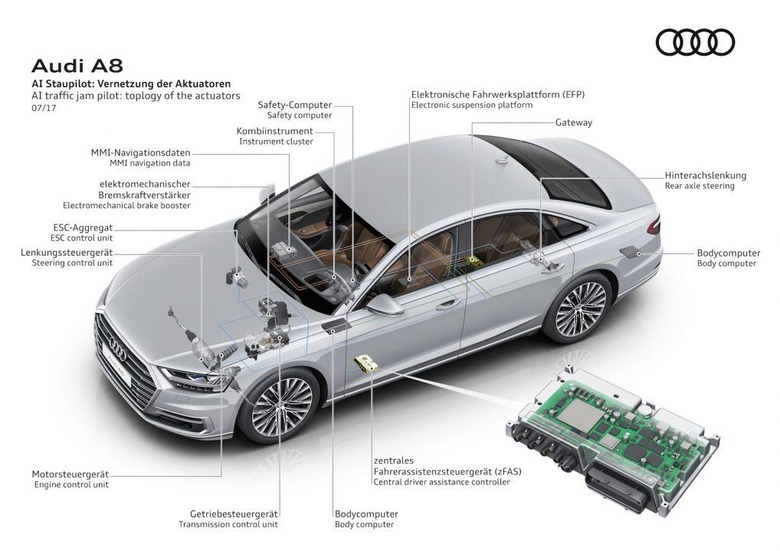
Audi is claiming the world's first automotive 'laser scanner' featuring a 145-degree viewing angle with a range of 80 meters (262 feet) ahead. Essentially it's a laser array, with its beams reflecting back from objects like cars, animals, and humans in a matter of milliseconds. It's located in the lower third portion of the front grille and gives the A8 its forward vision. Since it's vital to the system, Audi has added a heater that can melt away snow and ice that might form on it; the windshield wipers, meanwhile, help clear any dirt build-up from the monolens camera.
How’s the hardware and software redundant?
Radars, sensors, and cameras all have their strengths and weaknesses, and with today's technology they're sufficient for Level 3 driving. Still, what happens if the primary zFAS and all its software experiences a shutdown?
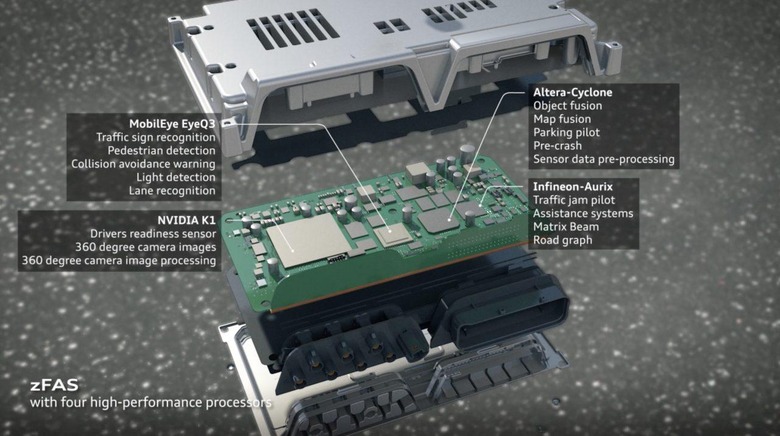
Using Microsoft HoloLens, Stefan showed me just what would happen in a worst-case scenario. Audi employs two separate teams of software developers for the software that controls every aspect of the decision-making process. There's the primary that's embedded in the zFAS, and the secondary software system – residing in the radar control unit and with bidirectional communication with the zFAS – that acts as an emergency backup.
"You can't simply copy and paste the same existing algorithm into another hardware controller as a backup system," Stefan explained, "because when there's a failure in the software, for the primary system, the same failure will be the same in the secondary system." You can think of it a little like math: how you arrive at the answer is only a small part of it, it's how you arrive at the solution that really matters.
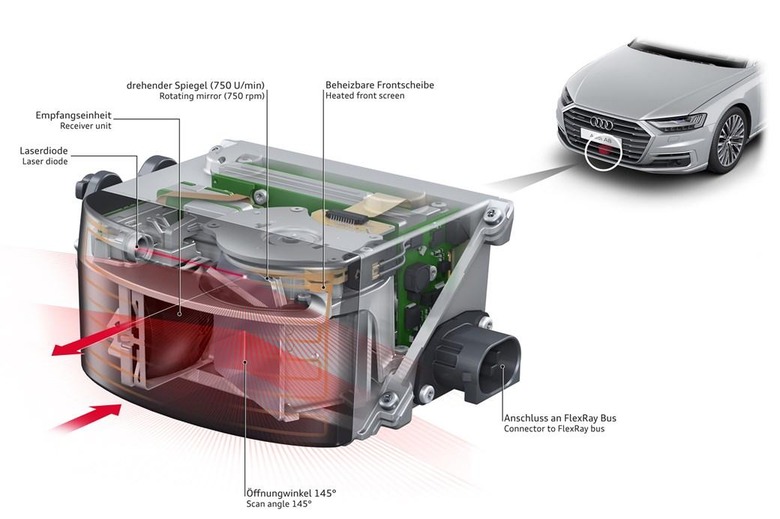
"Coming to a mathematical result of 3, you could calculate 1+1+1 or 3x1," Stefan points out, "same result, different ways to get to 3. So now you have to think ahead about software, where you can also get the same results with different procedures and methods." Audi took the strategy very seriously.
Indeed, it established two completely separate teams of software development projects. Each has the same goals, but every single line of code for the primary and secondary software are different. They're not allowed to collaborate, copy, or have any interaction with each other; that, Stefan says, is what Audi refers to as "heterogeneous redundancy."
Questions and unknowns
What happens during the 10 seconds when the car hands over control to the driver? Who's responsible? Audi or the driver? As of right now, Audi has told me that it's still something which needs to be defined, among many other variables to be clarified before AI traffic jam pilot is enabled. From what I understand, during the 10 second handoff Audi and the A8 would still be responsible, but the legal definition is yet to be, well, defined.
The US launch of the new A8 is expected in the Spring/Summer of 2018, so will traffic jam pilot be available? It's all still up in the air, because the statutory framework will need to be clarified in each individual country, along with the specific definition of the application and testing of the system. In addition, there are several approval procedures – which take different lengths of time to process – in other markets around the world.
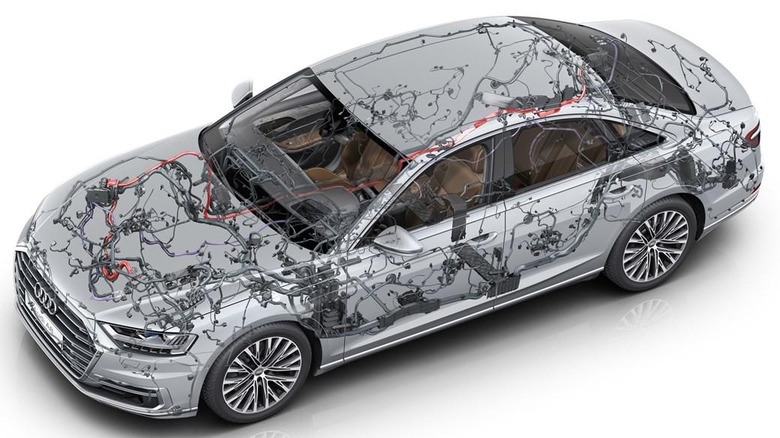
On top of that, Audi is currently unable to tell me whether the A8 will come equipped with all the sensors and other hardware, minus the traffic jam pilot software that's required to enable the feature. I suspect it will, but it's an important aspect that early-buyers will want to be clear on before they place an order. Assuming the automaker does take that route, it's still likely that you'll need to bring the car in to your dealer to have the feature enabled.
How much does traffic jam pilot cost? Again, we're still too far off to know for sure. Similarly, it's unclear if Audi will offer it at launch or later on.
Wrap-Up
Other automakers are shying away from Level 3 because, as one rival automaker has argued to me, "5 or 10 seconds isn't enough for the driver to take back control and that it could be dangerous." After having experienced traffic jam pilot as a passenger and, briefly, behind the wheel in a secure environment, however, I find myself seeing it as little different from adaptive cruise control and lane keep assist on, below the 37 mph limit. The only added dimension – by no means a small one, mind – is the added ability to take both eyes and hands off the steering wheel.
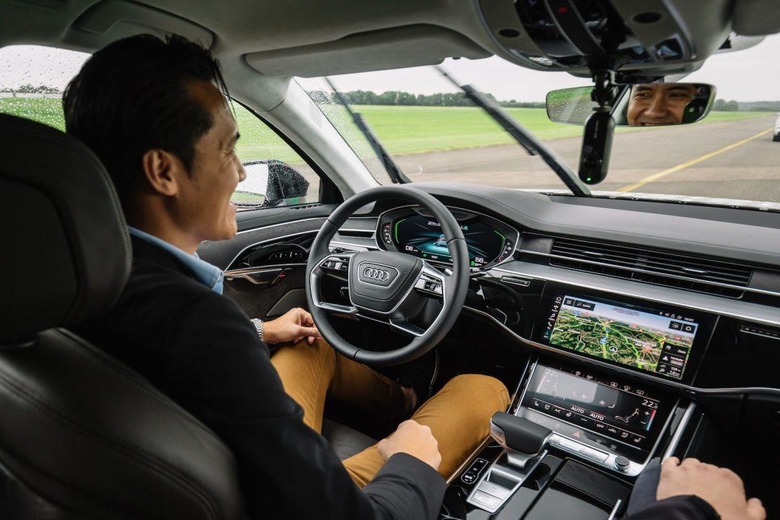
Playing Devil's advocate, in the event that a jerk cuts you off while the feature is engaged, even at the top end speed of 37 mph – though that may still be dangerous and could cause injuries – it's nowhere near the kind of high speed situation that can prompt a certain fatal accident. There's no override switch, either, meaning that if any of the conditions for traffic jam pilot aren't met, it's a complete no-go. As with any autonomous technology it'll take some work to safely bring it to public highways, but having handed over responsibility to the A8, even just temporarily, I'm confident Audi's balance of convenience and caution is sound.
